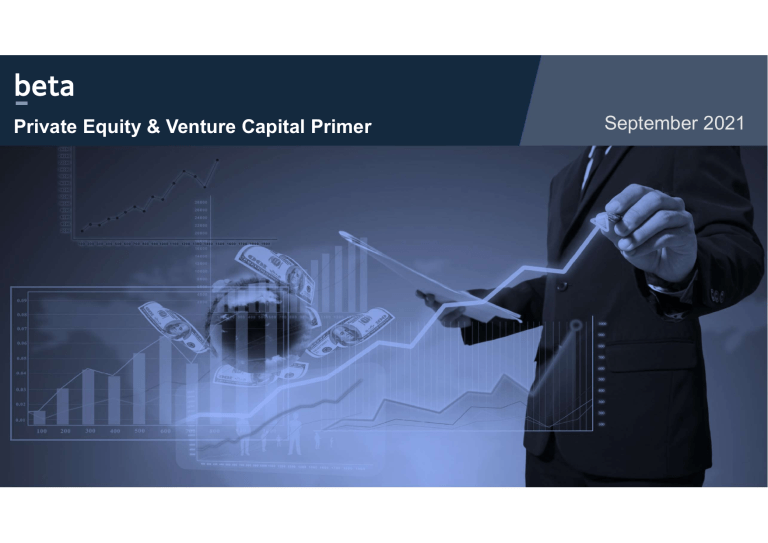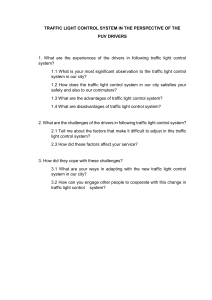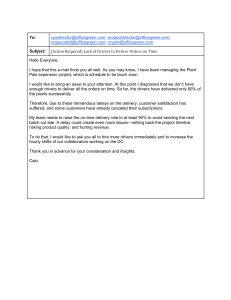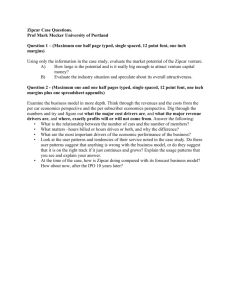
Private Equity & Venture Capital Primer September 2021 Part 1: Private Equity Using the PE Primer Use with IB Primer: The IB primer circulated by Beta contains the basics of valuation and financial concepts. Reading the PE primer along with the IB primer would help in getting a holistic view. Usually, PE preparation encompasses most preparation done for IB interviews. Additional elements are included in this primer. Other Sources: This primer is a start-point for your Private Equity preparation and is intended to point you towards the right sources of preparation. Hence, use other sources extensively throughout your preparation. De-construct top line Revenue Geography • • This analysis is valid for companies with presence across multiple markets For instance, Godrej Consumer reports revenue by Indonesia, India and Africa businesses for different products Channel • • A similar product can be sold through different channels and result in different cost structures and margin profiles For instance, general insurers sell insurance through bancassurance, agency, direct and via tie-ups Product • • This is used by companies with a wide & differentiated product assortment FMCG companies usually break down revenues by different products (HUL reports personal care, home care, refreshments, food etc.) Customer Segment • • Buying behaviour changes with customer segment. This breakdown is typically done at a product level, or at a company level for a company with a single product. Hotel companies typically have different customer segments Referring to the breakup given in the company’s investor presentation could be a good indicator of the relevant criteria for the company & the industry Estimating volume growth for the company Illustrative Pick up an industry/company Look through the annual report and analyst reports to identify key products/segments • Cement/Ultra Tech • • 4 main markets – North, South, West & Central The key customer segments in each market is housing (rural & urban), infrastructure, commercial and others Revenue • Understand underlying growth drivers for each elements Triangulate growth with macro variables Illustrative • • The drivers for housing growth are EWS housing schemes, availability of CLSS, government schemes such as IAY and PMAY (Estimate Cement MT/sq. ft construction) The driver for infrastructure is Govt schemes like freight corridors, Bharatmala project, metro construction etc. (Estimate Cement MT/km of road construction) Triangulate bottom up growth with growth in macro variables (GSDP growth per region) to close revenue projection Product 1 Product 2 Product 3 Market 1 Market 2 Market 3 Segment 1 Segment 2 Segment 3 Understand growth drivers A useful check is to verify the growth projection with the historical growth rates of the company to see whether they are reasonable. In case the short-term growth projection involves a recovery from COVID-19, have supporting data facts to show the pace of recovery Estimating price growth for the company A list of illustrative (non-exhaustive) factors to be considered for estimating a change in prices are: Market share/ market positioning: Different peers may occupy different positions in the market and pricing growth will depend on yield growth in segment rather than the overall market Product functionalities vs competitors: Product functionalities may vary across peers and the yield improvement may depend on growth in customer segment rather than the overall market Capacity utilization: Higher utilization peers may command more pricing power than lower utilization players Inflation expectation: Inflation expectations can influence pricing indirectly by pushing costs up/down Margin based pricing: For non-differentiated products and services, the product may be priced on a cost + margin basis. For those categories, cost drivers will explain margins Other factors: competitive dynamics, IP protection on innovation, demand sensitivity in market, number of intermediaries in marketing chain Try comparing your growth projections with analyst estimates available on Bloomberg/ Capital IQ/ other databases. They could help in substantiating the growth projections assumed for the company Key points to remember about revenue growth Be very granular while understanding growth Understand key drivers of growth; remember to keep those handy for interactions/buddy calls Focus on understanding historical/current state before projecting Avoid making unsubstantiated assertions: back your opinion with (multiple) data points. Try to triangulate the numbers to show better understanding of your estimates Try comparing your growth projections with analyst estimates available on Bloomberg/ Capital IQ/ other databases. They could help in substantiating the growth projections assumed for the company Getting to the Bottomline Costs Raw Material • • Primarily for manufacturing companies, raw material costs make a difference Can vary in case of industrials if the raw materials is a natural resource, and the company has mining rights Labour • • Is a big factor for services industry, for example – IT services Good to benchmark the labour/unit of output across industry in case labour makes a big portion of the costs Fuel/ Power • • In a manufacturing set up, fuel costs for running the production process can make a difference Depends on fuel prices, electricity tariffs, fuel efficiency, etc. Sales and Distribution costs • • • Cost of delivering the goods/services to the customers In manufacturing, logistics cost make a difference In services, sales and marketing expenses can be high Industry specific • • Express the costs in % terms while explaining to the interviewer so that it is easier to comprehend for the interviewer In each industry there are industry specific costs that need to be benchmarked For example – in banking, we need to track interest cost on deposits, claim ratios in insurance, etc. Estimating changes in margins for a company Illustrative Pick up an industry/company Look through the annual report and analyst reports to identify key costs heads in the P&L • Cement/Ultra Tech • • 3 main cost heads – raw material, fuel, logistics Identify the cost heads that cover 70-80% of the costs, and see how they vary across companies in the industry • Understand underlying drivers for each cost head Identify sources of cost reduction (margin improvement) for the company • • Drivers of raw material cost can be – presence of limestone mine within the plant, source of fly ash and slag, source of gypsum, etc. The drivers for logistics and fuel costs are primarily the crude prices, and the efficiency of company’s processes. These can be reduced by initiatives like Waste Heat Recovery, better network planning, etc. Illustrative Revenue Raw Material Fuel Labour Fuel mix Fuel efficiency Per unit cost Quality of fixed asset Technology Processes By benchmarking, identify cost heads where the company is performing worse compared to its competitors – analyse the reasons for the difference, and see if the company can close the gap Split each cost head into the maximum level of detail available and compare it with industry figures to identify key differences in cost structure between various companies. This could point to a sustainable competitive advantage for the company Key points to remember about cost structure Be very granular while understanding cost structure Understand key drivers of each cost head; remember to keep those handy for interactions/buddy calls Try to benchmark each cost head with the competitor companies, and see what is the source of difference, and whether the company can close the gap Look at per unit margins both in terms of percentage and rupees (difference can arise due to differences in prices across companies) Estimating the Unit Economics of a Company A good way of summarising the business model of the company is to estimate unit economics of a company wherein one establishes profitability at the unit level. The unit could differ based on the industry. For illustrative purposes, unit economics for cement industry is given below: Unit Economics (per Bag of Cement) Key Pointers 350 300 In addition to estimating the profitability per unit, do estimate the unit Return on Capital employed based on estimates of capital investment required for setting up capacity of 1 tonne/ bag of cement 33 250 200 150 35 65 331 265 100 56 233 198 168 148 50 0 Triangulate it with other metrics like NPV, IRR and payback period at a unit level, which would help in furthering your business understanding 50 92 MRP Dealer's Margin GST Net Realisation Raw Material Source: CRISIL Analyst Presentation – Nov 2019 Power & Fuel Freight 52 40 40 Gen. & Admin Exp EBITDA Analyzing differences in unit economics between competitors could help in quantifying the competitive advantage enjoyed by the company in relation to its competitors Other important factors to consider Working capital – understand the working capital cycle of the industry (in terms of receivables, inventory and payable days) – see how the company can improve the cycle. Understand how much investment in working capital is required each year Fixed assets – understand the committed and likely investment in fixed assets by the firm, and also the nature of the expenditure – whether it is replacement capex or capex for expansion Leverage – understand the extent of leverage by the firm in terms of – Debt to Equity, Debt to EBITDA, Interest Coverage and DSCR – this can show if there are chances that company can come into immediate distress, and if the company has the capacity to expand by leveraging more Dupont Analysis – This tool is a way to break down the Return on Equity and helps in identifying the return drivers of the company Fig: Dupont Analysis Return on Equity (Net Profit/ Equity) Return on Assets (Net Profit/ Assets) Net Profit Ratio (Net Profit/ Sales) Asset Turnover Ratio (Sales/ Assets) Assets/ Equity Preparation Checklist (1/4) Overall, the candidate needs to demonstrate a strong grasp on both the operational and financial side of business, especially how the two relate to each other (eg. How would an asset-light strategy show up on a P&L). Elements of both PE+IB preparation are recommended. Other specifics are detailed below: Technical/Industry Knowledge Detailed understanding of all drivers for an industry and company. Granular understanding of what moves revenues, costs and multiples for the chosen industry and how firms are positioned within the industry Strong grasp on FRA and Corporate Finance (be on top of Damodaran videos at the very least) A structured response to “How to Evaluate an investment opportunity” What-if scenarios – similar to a consulting case (in shorter form) About the Industry Different stages and rounds Difference between Angel funding, VC Funding and PE funding Difference between PE, VC, Asset Reconstruction Companies, etc. Page 13 Preparation Checklist (2/4) Stock Pitch Candidate is expected to present structured long-term view of the company as opposed to mere trading tips published in newspapers Expect detailed pushbacks on company fundamentals like product mix, poor margins or return ratios, etc. Strong industry understanding of the stock you’re pitching General Awareness Major PE funds in India and their investing philosophy. Their recent deals (form a view) Latest Deals and Funding rounds (optional but preferable) Company-specific Questions Portfolio of the company and recent deals One portfolio company you would invest in, one portfolio company you would not invest in View on the PE’s sector (in case of a sector-specific PE) Page 14 Preparation Checklist (3/4) HRQs Few Practice Questions Why PE? Do you invest. (If not) How can we trust you to manage investors’ money if you are not confident investing your own money? Strong probing questions on company/industry where you have worked in the past. Be on top of financials of key players in the industry What are your key weaknesses/strengths? * Ability to do quick mental math is appreciated in PE interviews. Page 15 Preparation Checklist (4/4) Sources Bloomberg (Analyst Reports) CRISIL (Industry Reports) The Ken Inc42 Venture-Intelligence (Deal Database) Mint – Especially the deal page Earnings call transcript of last few quarters Discussion with Analysts if possible Page 16 Venture Capital VC Primer The VC Process1 1. Deal Origination: There may be various sources of origination of deals like referrals or active search through networks, incubators, conferences, seminars, etc. 2. Screening: VCs undertake preliminary scrutiny of all projects on the basis of certain broad criteria, such as technology or product, market scope, size of investment, geographical location and stage of financing. 3. Evaluation: After a proposal has passed the preliminary screening, a detailed evaluation of the proposal takes place. A detailed study of project profile, track record of the entrepreneur, market potential, technological feasibility, future turnover, profitability, etc. is undertaken. 4. Deal Negotiation: Once the venture is found viable, the venture capitalist negotiates the terms of the deal with the entrepreneur. Terms of the deal include amount, form, price and seats on the board. 5. Post-Investment Activity: VCs track the performance of their portfolio companies and assist the founders by leveraging their network. 6. Exit Plan: The last stage of venture capital financing is the exit to realise the investment so as to make a profit/minimize loss. Exit can be through selling its stake to another VC/PE, acquisition by a corporate, or an IPO. 1. https://www.yourarticlelibrary.com/financial-management/venture-capital/process-of-venture-capital-financing-6-main-steps/72037 How to analyse (due diligence) a start-up? VCs look at companies which are in the earlier stages (start-ups) of their business cycle. Therefore, VCs would be betting more on emerging technologies and new business models. Since most of these businesses would not have any reliable financial history, the conventional evaluation techniques are futile. The following are the key aspects that should be assessed: 1. Huge market potential 2. Differentiating technology/product 3. Founding team pedigree These criteria are quite logical. If the market is too small, it doesn’t matter how great the product or service is, it just won’t have a big impact. If the technology is too similar to other competitors, then the odds of breaking away from the pack are low. Finally, without incredible people, neither of the other two criteria matter. Framework for Evaluation of Start-ups Market Potential Product Team • Market size • Product market fit • Experience/skills • Market forces and trends • Differentiation • Founder dynamics • Market readiness • Customer feedback • Passion • Regulations • Legal defensibility • Vision for the business • Evolution Competitive landscape & defensibility Economics & scalability Funding and Exit potential • Alternatives • Unit economics • Investment required • Degree of competition • Operating margins (current & • Strategic vs financial • Scale and funding of competitors • Competitive and sustainable advantages steady state) • Traction and adoption potential • Potential exit value • Time frame • GTM strategy and business model • Capital efficiency 20 Preparation Checklist 1. Know your VC: Understand the investment philosophy, current portfolio and latest investments. Try to understand what stage the VC prefers investing in and the average ticket size of funding. 2. Basic HRQs: An illustrative list: i. Why do you want a job in Venture Capital? ii. Why do you want to work for our firm? iii. What is happening in the industry currently? Which are the themes that you are bullish on? (Refer Additional Reference Material point number 1 to track latest trends/developments) 3. Start-up pitch/evaluation: Analyze at least one start-up based on the following criteria: i. Founding team ii. Market potential iii. Growth drivers iv. Product/Technology differentiation Page 21 Additional Reference Material 1. Latest developments: Andreessen Horowitz blogs & podcasts, TechCrunch, Inc42, YourStory, The Ken, etc. 2. VC and start-up databases: Crunchbase, Tracxn, PitchBook, CB Insights, etc. 3. Valuing a start-up: https://masschallenge.org/article/how-to-value-a-startup-company-with-no-revenue 4. Unit Economics: https://www.lightercapital.com/blog/what-are-unit-economics/ All the Best!




